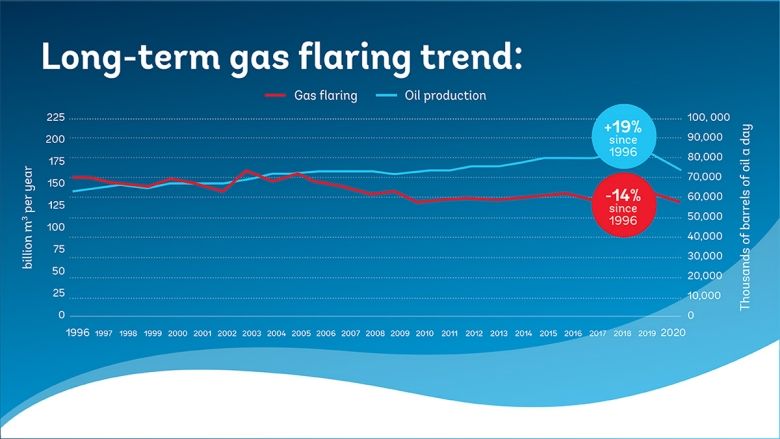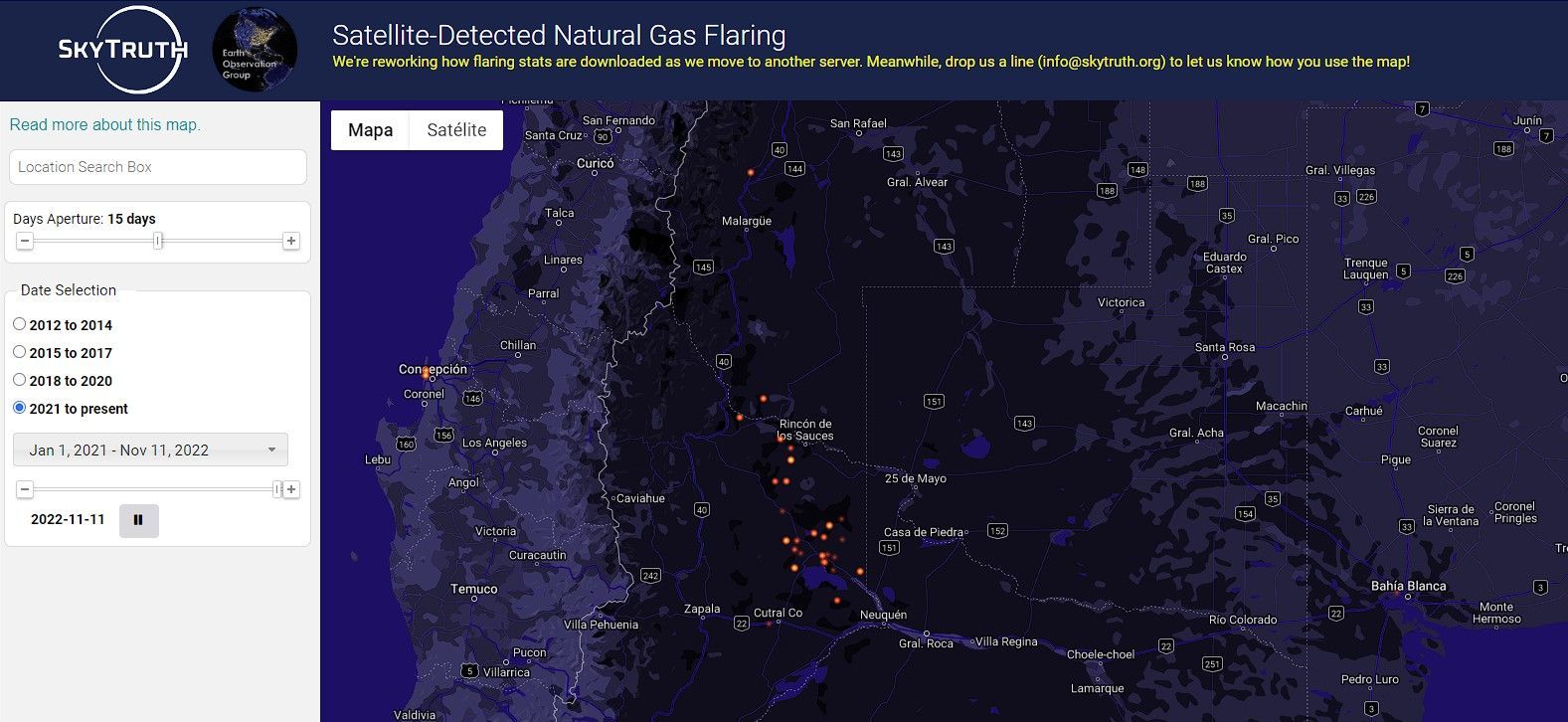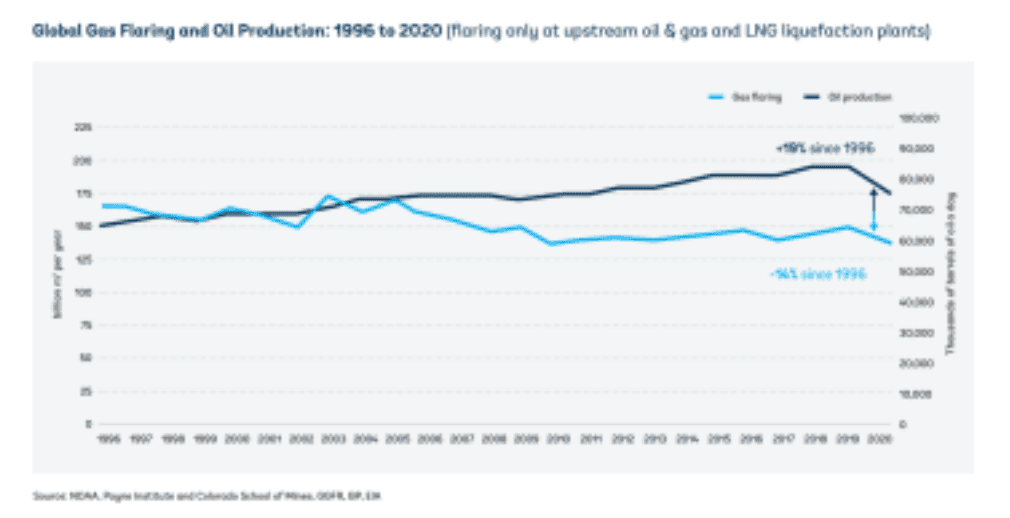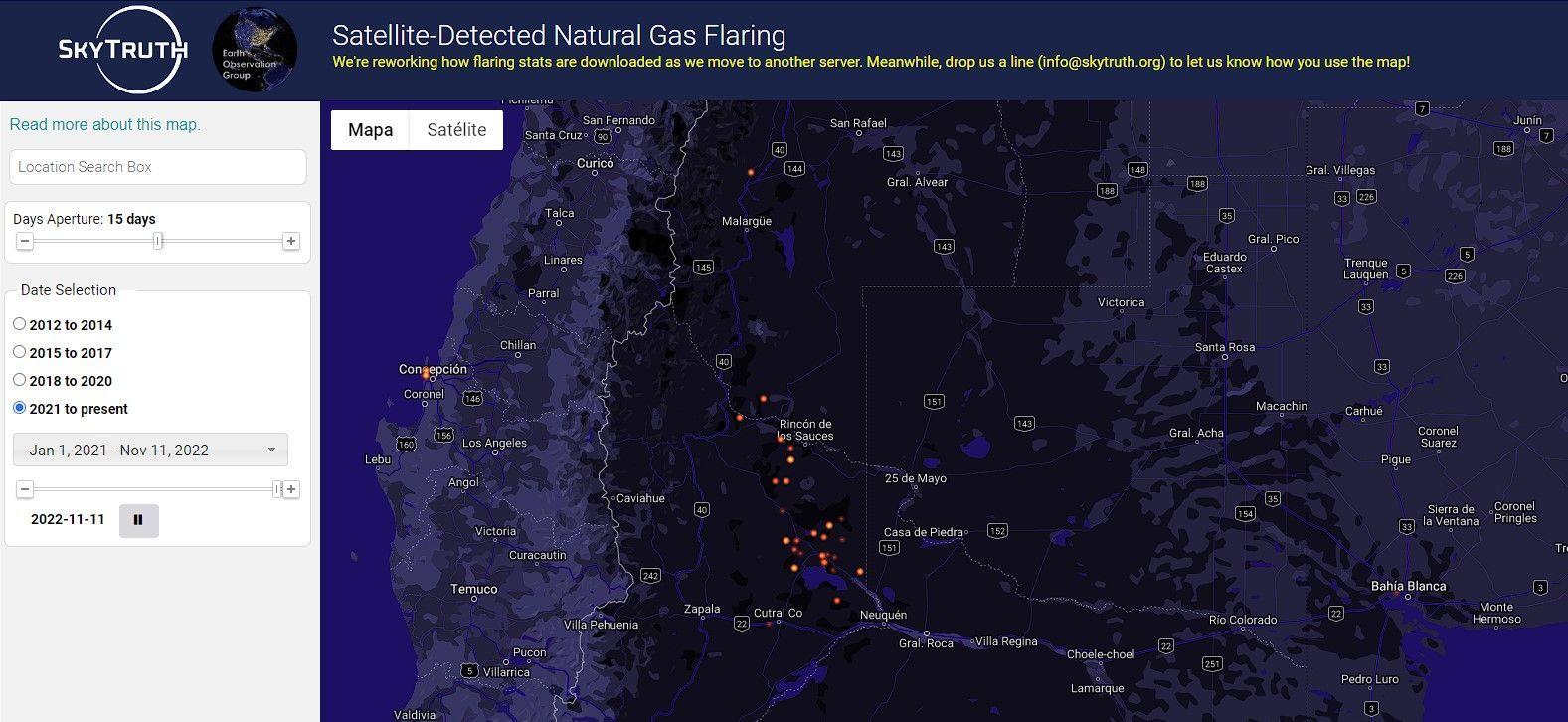Venteu or gas apron (flaring gas) is the burning of natural gas associated with oil extraction. The practice has persisted since the beginning of oil production for more than 160 years and is carried out due to a variety of problems, from economic and market limitations to the lack of adequate regulation and political will. The amount of gas that currently burns annually in thousands of torches worldwide (about 142 billion m3 in 2020) could supply the entire sub-Saharan Africa.What are the environmental impacts? Each m3 of gas burning generates 2.8 kg of equivalent CO2 emissions (over 400 million tons/year). Methane emissions resulting from combustion inefficiency contribute to global warming and black carbon (hollín) for local pollution.Globally since the early 1990s there have been marked improvements in a variety of regions and contexts. The US, through the construction of gas-use infrastructure, has reduced 70% or 5,500 million m3 of the global decrease. In our country, the veneus have been associated with the hydrocarbon exploitation in distant fields to capture infrastructure. For a long time in the Neuquina basin it was common to see the “matches" burning in torches. With the discovery in the mid-1980s and the oil production of the Filo Address deposit, several million m3/day of gas were launched in the atmosphere.From Neuquén, in an innovative way, we wanted to take advantage of this with private and risk investments. But the province could not have the gas produced, but only request 12% royalties in kind. For this, the local instance in 1991 the National Congress sanctions the law no. 24,009 that transferred free of charge to the provinces the gas sold by Y.P.F. State Society within its jurisdictions. It allowed the central Filo Address to be set in motion, which continues to provide the northern Neuquen electrical system.With increased production and associated venteos, added to the beginning of an environmental awareness by citizenship, companies and governments have generated recommendations, regulations and investments to limit them.It was thus that the Legislature of Neuquén sanctioned in the year 1996 the law n° 2.175 with the aim of guaranteeing the preservation of the environment, the protection of the health of the population and the rational exploitation of the resource. Prohibiting the veneus and creating an environmental rate for this type of emissions.At the same time since the Nation, two years later, Resolution 143/98 established restrictions on aprons with maximum gas/petroleum ratio and with exceptions; it should be burned, present a technical-economic study that demonstrates the inconvenience of its consumption, treatment, re-injection or other use; measure and record the aproduced flow and its composition.These bundles of measures were successful and managed to drastically lower emissions. Unfortunately, today associated with its growth, as a recurrence, the dilemma of the Veteans reappears as a side effect in Vaca Muerta.The complaint of Mr Raúl Muñoz for damage caused to the gas venteo requiring to know the amount of infringements and the fate of the money of the fines, shows the concern of a part of the leadership in this problem. Muñoz asked: “if in addition to loss by legal veteu, there is loss by illegal venteo? What if indiscriminate exceptions were granted to the veneer limits? In the last report of the “Control and Evaluation of Petroleum Activity” of the Department of Energy of the Nation March 21, only in the Province of Neuquén were detected 330 thermal anomalies corresponding to veteos.(3)
In our country, the veneus have been associated with the hydrocarbon exploitation in distant fields to capture infrastructure. For a long time in the Neuquina basin it was common to see the “matches" burning in torches. With the discovery in the mid-1980s and the oil production of the Filo Address deposit, several million m3/day of gas were launched in the atmosphere.From Neuquén, in an innovative way, we wanted to take advantage of this with private and risk investments. But the province could not have the gas produced, but only request 12% royalties in kind. For this, the local instance in 1991 the National Congress sanctions the law no. 24,009 that transferred free of charge to the provinces the gas sold by Y.P.F. State Society within its jurisdictions. It allowed the central Filo Address to be set in motion, which continues to provide the northern Neuquen electrical system.With increased production and associated venteos, added to the beginning of an environmental awareness by citizenship, companies and governments have generated recommendations, regulations and investments to limit them.It was thus that the Legislature of Neuquén sanctioned in the year 1996 the law n° 2.175 with the aim of guaranteeing the preservation of the environment, the protection of the health of the population and the rational exploitation of the resource. Prohibiting the veneus and creating an environmental rate for this type of emissions.At the same time since the Nation, two years later, Resolution 143/98 established restrictions on aprons with maximum gas/petroleum ratio and with exceptions; it should be burned, present a technical-economic study that demonstrates the inconvenience of its consumption, treatment, re-injection or other use; measure and record the aproduced flow and its composition.These bundles of measures were successful and managed to drastically lower emissions. Unfortunately, today associated with its growth, as a recurrence, the dilemma of the Veteans reappears as a side effect in Vaca Muerta.The complaint of Mr Raúl Muñoz for damage caused to the gas venteo requiring to know the amount of infringements and the fate of the money of the fines, shows the concern of a part of the leadership in this problem. Muñoz asked: “if in addition to loss by legal veteu, there is loss by illegal venteo? What if indiscriminate exceptions were granted to the veneer limits? In the last report of the “Control and Evaluation of Petroleum Activity” of the Department of Energy of the Nation March 21, only in the Province of Neuquén were detected 330 thermal anomalies corresponding to veteos.(3) On the Website skytruth (make it true)(1) is shown a map of gas burning across the planet. It is updated daily to add new infrared detections that are warm enough to be considered as aprons. In a notorious form emerge the Veteans of the shale of Cow Muerta:We are not among the first 10 countries more Winners but there are alarm signs by total volume and intensity increases (ratio of m3 gas vetoed by barrel of raw produced). It also increased the Argentine IFG, increasing imports of fuels without targeting its origin (Global Venteo Index which aims to quantify the concept that, if a country is importing raw from producing countries, it is also importing the burning intensity of these producing countries in proportion to the amount of imported oil).Within the World Bank, a trust fund of multiple donors comprised of governments, oil companies and multilateral organizations committed to ending routine gas burning: Global Gas Flaring Reduction Partnership (GGFR or World Association for Gas Venteos Reduction) and publishes Global Gas Flaring Tracker 2020 which is a leading global indicator independent of gas burning(2). Our country does not participate.The burning is of course totally unproductive and can be avoided much more easily than many other sources of greenhouse gas emissions (GEI). Technology and innovation have been shown to be allied to these improvements. Unlike 20 years ago, there are less cost and more accurate measurements, viewing-following-s estimates via satellite and more efficient, more economical and new alternatives to capture or re-inject:Electricity generation with torch gas (used to crypto-mining in situ, for network connection or use in the deposit, through micro and large gas or steam turbines, alternative internal combustion engines or co-generation.Torch Gas Rejection in the secondary recovery of oil: it can be injected into ancient wells to restore the natural training pressure in decrease and maintain the production results. This self-sufficient cycle is quite economic because the waste generated is minimal and increases the overall efficiency of the process.Transformation in GTL, LNG or GNC: Gas The Liquid: in the last decade there was an accelerated trend of large-scale conversion to small-scale technologies and smaller plants became a viable option for monetization of torches, with capital costs per unit equal or smaller than plants worldwide; Licuado Natural Gas, licuar and store the associated gas is a safer and cost-effective alternative to gas burning. After debugging processes, LNG can be stored for both industrial and domestic use; Natural Gas Pills high pressure as vehicular use.We should occupy ourselves immediately and seriously in this problem, adjusting normative, focusing on controls and supervision, publishing statistics, adhering and participating in GGFR, minimizing with captures the unwanted effect derived from the production of shale A lot of cow and avoiding negative experiences for the industry as with the treatment of waste in the industry.The great danger is that impatience and improvisation are allied and destroyed the effort in decreasing the wombs as it was succeeded 20 years ago: “The one who cannot remember the past is doomed to repeat”.Reference:(1)https://viirs. skytruth. org/apps/heatmap/flaringmap. html#lat=29.43243&lon=15.26825&zoom=3&o ffset=15; Advanced sensors of these satellites detect the heat emitted by gas flames as infrared emissions at global oil and gas installations. The Colorado Mine School and GGFR quantify these infrared emissions.(2)https://thedocs. worldbank. org/en/doc/1f7221545bf1b7c89b850dd85cb409b0- 0400072021/original/WB-GGFR-Report-Design-05a. pdf;https://www.ggfrdata.org/(3)http://sig.se.gob.ar/visor/timeline_venteos/informes_pv/107_Informe_marzo_2021.pdf
On the Website skytruth (make it true)(1) is shown a map of gas burning across the planet. It is updated daily to add new infrared detections that are warm enough to be considered as aprons. In a notorious form emerge the Veteans of the shale of Cow Muerta:We are not among the first 10 countries more Winners but there are alarm signs by total volume and intensity increases (ratio of m3 gas vetoed by barrel of raw produced). It also increased the Argentine IFG, increasing imports of fuels without targeting its origin (Global Venteo Index which aims to quantify the concept that, if a country is importing raw from producing countries, it is also importing the burning intensity of these producing countries in proportion to the amount of imported oil).Within the World Bank, a trust fund of multiple donors comprised of governments, oil companies and multilateral organizations committed to ending routine gas burning: Global Gas Flaring Reduction Partnership (GGFR or World Association for Gas Venteos Reduction) and publishes Global Gas Flaring Tracker 2020 which is a leading global indicator independent of gas burning(2). Our country does not participate.The burning is of course totally unproductive and can be avoided much more easily than many other sources of greenhouse gas emissions (GEI). Technology and innovation have been shown to be allied to these improvements. Unlike 20 years ago, there are less cost and more accurate measurements, viewing-following-s estimates via satellite and more efficient, more economical and new alternatives to capture or re-inject:Electricity generation with torch gas (used to crypto-mining in situ, for network connection or use in the deposit, through micro and large gas or steam turbines, alternative internal combustion engines or co-generation.Torch Gas Rejection in the secondary recovery of oil: it can be injected into ancient wells to restore the natural training pressure in decrease and maintain the production results. This self-sufficient cycle is quite economic because the waste generated is minimal and increases the overall efficiency of the process.Transformation in GTL, LNG or GNC: Gas The Liquid: in the last decade there was an accelerated trend of large-scale conversion to small-scale technologies and smaller plants became a viable option for monetization of torches, with capital costs per unit equal or smaller than plants worldwide; Licuado Natural Gas, licuar and store the associated gas is a safer and cost-effective alternative to gas burning. After debugging processes, LNG can be stored for both industrial and domestic use; Natural Gas Pills high pressure as vehicular use.We should occupy ourselves immediately and seriously in this problem, adjusting normative, focusing on controls and supervision, publishing statistics, adhering and participating in GGFR, minimizing with captures the unwanted effect derived from the production of shale A lot of cow and avoiding negative experiences for the industry as with the treatment of waste in the industry.The great danger is that impatience and improvisation are allied and destroyed the effort in decreasing the wombs as it was succeeded 20 years ago: “The one who cannot remember the past is doomed to repeat”.Reference:(1)https://viirs. skytruth. org/apps/heatmap/flaringmap. html#lat=29.43243&lon=15.26825&zoom=3&o ffset=15; Advanced sensors of these satellites detect the heat emitted by gas flames as infrared emissions at global oil and gas installations. The Colorado Mine School and GGFR quantify these infrared emissions.(2)https://thedocs. worldbank. org/en/doc/1f7221545bf1b7c89b850dd85cb409b0- 0400072021/original/WB-GGFR-Report-Design-05a. pdf;https://www.ggfrdata.org/(3)http://sig.se.gob.ar/visor/timeline_venteos/informes_pv/107_Informe_marzo_2021.pdf
10/27/2022 - politics-and-society
Cow Muerta “On Fire”
Do you want to validate this article?
By validating, you are certifying that the published information is correct, helping us fight against misinformation.

ruben etcheverry
Hi, I am Rubén Etcheverry, I studied engineering at the National University of La Plata, where I graduated from Hydraulic Engineer, Engineer in Construction and Civil Engineer, and later graduated from Business Administration at UCEMA. I specialised in various energy content in Spain, Italy, Israel and Japan. I worked as Operations Manager and New Energy Business Argentina S.A. and as President of Enarsa Services S.A.
I served as Assistant Secretary of Energy of the Province of Neuquén between the years 1995 and 1999, and I was President of the company Hydrocarbons of Neuquén S.A. (HIDENESA) in the same period. I am the author of the book "Yeil, The New Reserves: the Development of Dead Vaca in Neuquén".
Total Views: 38





Comments